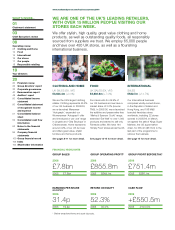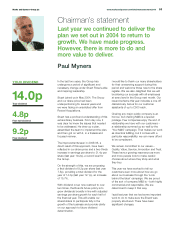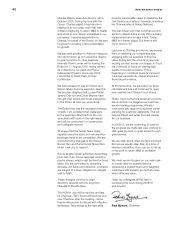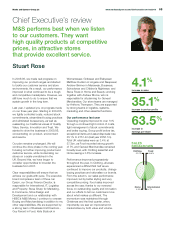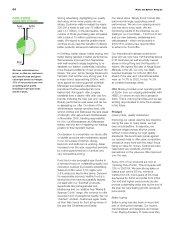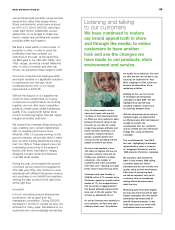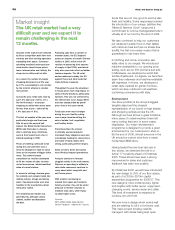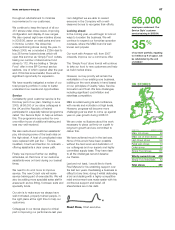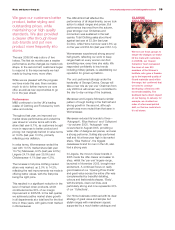Marks and Spencer 2006 Annual Report Download - page 8
Download and view the complete annual report
Please find page 8 of the 2006 Marks and Spencer annual report below. You can navigate through the pages in the report by either clicking on the pages listed below, or by using the keyword search tool below to find specific information within the annual report.
06 Marks and Spencer Group plc
foods that are not only good to eat but also
fresh and healthy. Some responses included
the introduction of our unique, additive-free
‘Marks & Spencer Cook!’ range and a
commitment to remove hydrogenated fats in
virtually all of our food by the end of 2006.
We also continued to help our customers
put restaurant quality food on their tables
with minimum fuss such as our stress-free
soufflé, the first oven-ready version that is
guaranteed to rise every time.
In Clothing and Home, innovation also
adds value to our ranges. We introduced
machine-washability to our opening price
suiting, such as our £50 women’s suit and,
in Menswear, we developed a world-first
tumble-dryable suit. In Lingerie, we launched
seam-free underwear and machine-washable
silk nightwear. In Home, we developed a
rattan-style material for garden furniture,
which can stay outdoors in all weathers,
combining convenience with style.
Environment
Our store portfolio is the Group’s biggest
tangible asset and the physical
representation of our brand on high streets
and shopping centres across the UK.
Although we have stores in great locations,
many years of underinvestment have left
many looking tired and, in some cases,
dilapidated. Our major refurbishment
programme is designed to provide a great
environment for our customers to shop in.
By the end of 2006, almost everyone in the
UK should be a short drive from a newly
modernised M&S store.
Having tested the new look last year in
four stores, we extended the trial to a
further 17 locations ahead of Christmas
2005. These stores have seen a strong
improvement in sales and customer
feedback has been very positive.
By Christmas 2006, we will have introduced
the new design to 35% of our floor space,
as part of a £520m-£570m capital
expenditure programme for 2006/07. This
new design is more contemporary, lighter
and brighter with better layout, equipment,
changing rooms, service areas and cafés.
This level of investment is expected to
continue into 2007/08.
We now have a design which works well
and are seeking to roll it out at lower cost.
This major project is being carefully
managed, with stores being kept open
Market insight
The UK retail market had a very
difficult year and we expect it to
remain challenging in the next
12 months.
All parts of the market were affected
by fierce competition both from new
entrants and from existing operators
expanding their space. Consumer
spending remained under pressure
amid worries about house prices,
taxes, interest rates and, latterly, the
sharp rise in utility and fuel bills.
As a result, the number of people
shopping decreased over the year
by 2.1%, exacerbated in city centres
by the terrorist attacks in London
last summer.
Across the year, retail sales rose by
just 1.6% (last year +5.4%). On a
like-for-like basis – a measure
stripping out sales from stores open
for less than a year – sales fell by
1.4% (last year +1.8%).
The first six months of the year were
particularly tough and there was
little let-up in the second half.
Indeed, the British Retail Consortium
(BRC) said that sales in January,
after a relatively busy Christmas,
were at their lowest level since it
started reporting in 1995.
Prices of clothing continued to fall
during the year and there was a
trend for shoppers to look for value
items at the expense of bigger ticket
items. This stoked intense
competition as retailers attempted
to lift the volume of sales to make
up for lower prices, which benefited
sales of casual clothes.
In women’s clothing, demand grew
for celebrity and catwalk trends like
military jackets, shrugs and skinny
jeans. Casualwear sales were also
healthier in the less fashion-driven
menswear market.
The childrenswear market was
generally flat, although school
clothes, toddler and babywear
did best.
Following calls from a number of
member states, the EU imposed
quotas on imports of certain Chinese
textiles in 2005, which led to UK
retailers re-assessing their sources
of supply. In April 2006, provisional
duty also came into effect on leather
footwear imports. The UK retail
sector continues to lobby the EU
against these and other potential
trade defence measures.
Throughout the year, the slowdown
in house prices had a big impact on
sales of home products, particularly
furniture. This was not stemmed by
the interest rate cut in August 2005
and was compounded by petrol
price rises in the same month.
Food sales were much stronger
during the year. Healthy eating
was a major trend benefiting the
sale of salads, fruit, vegetables
and healthy drinks.
From December, the interest
in ethically sourced products
increased. Busy shoppers were also
increasingly looking for convenience
and sales of ready meals were
strong, particularly premier ranges.
Sales of wines, beers and spirits
were lifted by frequent promotions.
Analysts continue to forecast
sluggish activity in the retail market.
Pressure on spending is unlikely to
relax while consumers continue to
worry about debt, rising bills and
soft house prices.
With retailers continuing to
expand their space and compete
fiercely on price, they will be under
pressure to lift their volumes to
maintain total sales, while trying
to offset higher costs.
Sources:
BRC-KPMG Retail Sales Monitor
Verdict Research, ‘retailverdict’ reports


